Crassula atropurpurea placed in the wrong Section / Crassula atropurpurea placée dans la mauvaise Section
by Margrit Bischofberger
Crassula atropurpurea is a shrubby plant with erect stems and oblong or oblanceolate, glabrous or minutely papillose leaves which may turn deep red. The flowering stems are quite long with up to 5 sterile bracts, the peduncle is puberulous or glabrescent and the 5-merous flowers are arranged in stalked dichasia.
--------------------------------------------------------------------------------------------------------------------------
par Margrit Bischofberger
Crassula atropurpurea est une plante buissonnante, à tiges dressées, et feuilles oblongues ou oblancéolées, glabres ou finement papilleuses pouvant devenir rouge foncé. Les tiges florifères sont très longues, avec jusqu'à 5 paires de bractées stériles, le pédoncule est pubérulent ou glabrescent, et les fleurs pentamères sont arrangées en dichasia pédonculés.
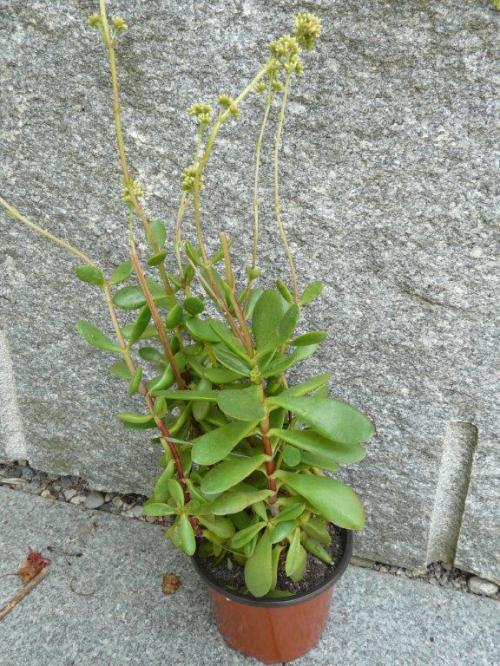
Crassula atropurpurea var. atropurpurea
C. atropurpurea originally was described by Haworth (1824) as Globulea atropurpurea, a plant similar to Globulea (Crassula) cultrata, both having "globules" (appendages) at the petal tips - hence the generic name Globulea.
In his thesis "A Revision of the Genus Crassula in Southern Africa" (1977) Tölken reduced Haworth's genus Globulea to a section within his very diverse genus Crassula. And he followed Haworth and described C. atropurpurea as having "petals panduriform, [...] each with an elongate dorsal appendage in a terminal position but often more or less ventrally canaliculate [...] with or without membraneous petal apex curved inwards"(p. 523) and included it in his new section Globulea.
-------------------------------------------------------------------------------------------------------------------
C. atropurpurea fut à l'origine décrit par Haworth (1824) en tant que Globulea atropurpurea, une plante similaire à Globulea (Crassula) cultrata, les deux ayant des « globules » (appendices) aux extrémités des pétales, d'où le nom générique Globulea.
Dans sa thèse A Revision of the Genus Crassula in Southern Africa (1977) Tölken réduisit le genre Globulea de Haworth en une section, au sein de son genre très varié Crassula. Il suivit Haworth et décrivit C. atropurpurea comme ayant des « pétales panduriformes, [...] chacun avec un appendice dorsal allongé, en position terminale, mais souvent plus ou moins canaliculé intérieurement [...] avec ou sans apex pétalaire membraneux courbé vers l'intérieur » (p. 523), et l'inclut dans sa nouvelle section Globulea.
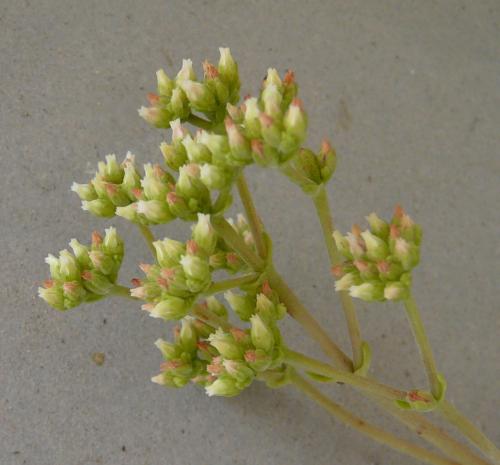
Inflorescence of / de Crassula atropurpurea
However subsequent to this description he wrote : "C. atropurpurea is distinguished from C. cultrata and most other species in this section by its more or less canaliculate dorsal petal appendage, so that in extreme cases it appears as if the appendage is completely absent." This additional characterisation is not only contradictory to his own preceeding description but is also clearly inconsistent with Haworth's description of Globulea atropurpurea because it lacks exactly the feature which is distinctive for species of genus or sect. Globulea, namely the globular petal appendage. However it corresponds perfectly to his description of a flower of the Sphaeritis type : "Characteristically the petal apex is drawn in a narrow canaliculate point accompanied by the disappearance of the dorsal appendage." (p.14).
-------------------------------------------------------------------------------------------------------------------
Cependant, suite à cette description, il écrivit : « C. atropurpurea se distingue de C. cultrata et d'autres espèces, au sein de cette section, par son appendice pétalaire dorsal plus ou moins canaliculé, si bien que dans certains cas extrêmes l'appendice semble complètement absent. » Cette caractéristique additionnelle n'est pas seulement contradictoire avec sa propre description précédente, mais est aussi incohérente avec la description de Globulea atropurpurea effectuée par Haworth, puisqu'il manque exactement la caractéristique qui définit l'espèce du genre (ou section) Globulea, à savoir l'appendice globulaire du pétale. Cela correspond néanmoins parfaitement à sa description florale de type Sphaeritis : « De manière caractéristique, l'apex du pétale se termine en une étroite pointe canaliculée accompagnée d'une disparition de l'appendice dorsal » (p.14).
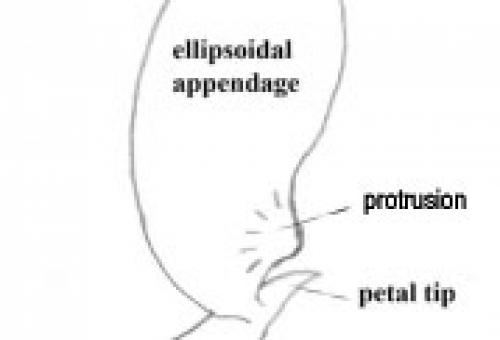
Diagram of the petal tip and appendage of Crassula cultrata, the type species of Crassula sect. Globulea (drawn by Roy Mottram).
Schéma de l'extrémité du pétale et de l'appendice de Crassula cultrata, espèce type de Crassula sect.Globulea (dessiné par Roy Mottram).
So all of a sudden the name C. atropurpurea is used for a plant without "globules" at the petal tips. This makes it possible to synonymise 4 other species : C. obliqua Haworth, C. clavifolia Harvey, C. micrantha Schönl. and C. smutsii Schönl., all with flowers without globular petal tips. However - and this is really incomprehensible and of course erroneous - still heading the list of the synonyms included in C. atropurpurea var. atropurpurea is Haworth's Globulea atropurpurea. It looks as if Tölken had forgotten to remove it after having abandoned Haworth's concept of atropurpurea, moreover he seems to be oblivious to the fact that the name C. atropurpurea cannot be used for a species lacking the globular petal appendage.
------------------------------------------------------------------------------------------------------------------------------
Soudainement, le nom C. atropurpurea a ainsi été employé pour une plante sans « globules » aux extrémités des pétales. Ce qui rend impossible la mise en synonymie de quatre autres espèces : C. obliqua Haworth, C. clavifolia Harvey, C. micrantha Schönl. et C. smutsii Schönl., toutes ayant des pétales sans extrémités globulaires. Cependant - et cela est vraiment incompréhensible et bien sûr erroné - la Globulea atropurpurea de Haworth est toujours en tête de liste des synonymes inclus dans C. atropurpurea var. atropurpurea. C'est comme si Tölken avait oublié de le déplacer après avoir abandonné le concept atropurpurea de Haworth, et il semble de plus avoir oublié que le nom C. atropurpurea ne peut être utilisé pour une espèce à laquelle manque l'appendice globulaire du pétale.
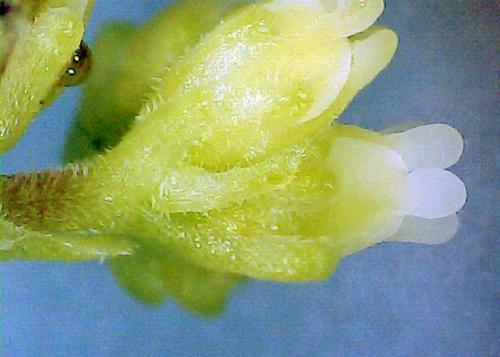
Photo of a Crassula cultrata flower showing the prominent petal appendages which are outgrowths from a point below the petal tip, not at the tip, i.e. not terminal.
Photo Roy Mottram
Photo d'une fleur de Crassula cultrata montrant les appendices pétalaires proéminents, lesquels sont des excroissances à partir d'un point sous l'extrémité du pétale, et non à l'extrémité (c'est-à-dire en position terminale).
Photo de Roy Mottram
The oldest available name of the non-Globulea species synonymised by Tölken under var. atropurpurea is C. clavifolia, described as having petals gradually tapering into a channelled point. This is the name which should be used for what is now called C. atropurpurea var. atropurpurea and this group of plants should be removed from sect. Globulea; it could be transferred to sect. Argyrophylla.
--------------------------------------------------------------------------------------------------------------------
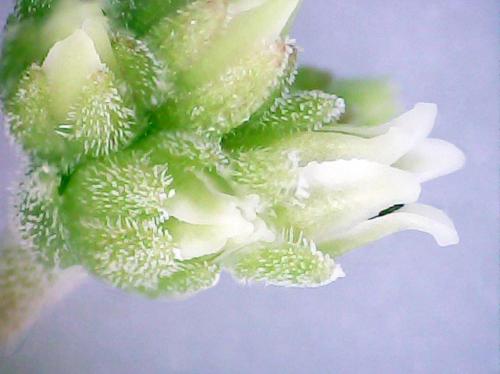
Swollen petal tips of a typical member of sect. Argyrophylla (Crassula sericea var. velutina). There is a groove at the petal tip which cannot be seen clearly in this photo but it is always present (canaliculate). The small bump behind the petal tip is not always present, but it is in the same position where the appendage of sect. Globulea occurs.
Photo Roy Mottram
Extrémité pétalaire élargie d'un membre typique de la sect. Argyrophylla (Crassula sericea var. velutina). Il y a un sillon (canalicule) à la pointe du pétale qui ne peut être vu clairement sur cette photo, mais il est toujours présent. La petite bosse derrière l'extrémité du pétale n'est pas toujours présente, mais elle se situe au même endroit ou naît l'appendice chez la sect. Globulea.
Photo de Roy Mottram
Tölken not only dismissed the original concept of C. atropurpurea, but he also expanded his C. atropurpurea considerably by including C. anomala, C. cultriformis, C. purcellii, C. rubella and C. watermeyeri, reasoning that they are all growing in the same region, that populations often are overlapping and sometimes even hybridising. However the fact that populations overlap and hybridise is not a sufficient reason for lumping them, and even less so as this "region" extends from south-western Namibia in the North to the Table Mountain in the South and to Port Elizabeth in the East.
While var. atropurpurea is usually a glabrous plant, 4 of the new varieties (anomala, purcellii, rubella and watermeyeri) are distinctly hairy; none of the 5 new varieties has the flower type requisite for sect. Globulea, all have panduriform petals, those of cultriformis, purcellii, rubella and watermeyeri have a canaliculate petal apex, only var. anomala has a prominent dorsal petal appendage, more or less canaliculate on the ventral surface, which means that var. anomala is somewhat in between the Globulea and the Sphaeritis flower type. So this expansion is by no means a justification for keeping C. atropurpurea in sect. Globulea and these newly added varieties should be removed and transferred as well and probably be reinstated as species.
Footnote
On p. 526 Tölken explains that in the absence of a preserved specimen he has chosen a plate executed by Duncanson as the lectotype for Crassula atropurpurea. This plate is baffling. The illustrated plant has very strange flowers, none is open and the exserted part looks like a 5-lobed stigma, something impossible for a Crassula - in short no resemblance to Globulea flowers. On the sheet two names are noted : "Kalosanthes atropurpurea Haw." and "a form of C. obvallata". It is unclear who had added the latter name, but it is known that also Schönland (1929: 281) considered the Duncanson atropurpurea plate to represent C. obvallata : "... according to Haworth's drawing at Kew it seems to belong to C. obvallata L." Why had Tölken chosen a plate attributed rather to C. obvallata and with completely misinterpreted flowers as lectotype for C. atropurpurea?
The plate is published here : http://www.crassulaceae.ch/de/artikel?akID=31&aaID=2&aiID=A&aID=3185
------------------------------------------------------------------------------------------------------------------------
Tölken n'a pas seulement écarté le concept original de C. atropurpurea, mais il a aussi considérablement agrandi sa C. atropurpurea en incluant C. anomala, C. cultriformis, C. purcellii, C. rubella et C. watermeyeri, affirmant qu'elles poussent toutes dans la même région, et que les populations se chevauchent souvent, s'hybridant parfois. Cependant, le fait que des populations se chevauchent et s'hybrident n'est pas une raison suffisante pour les regrouper, et encore moins le fait que cette région s'étende depuis le sud-ouest namibien, au nord, jusqu'à la Table Mountain au sud et Port Elizabeth à l'est.
Alors que la var. atropurpurea est habituellement une plante glabre, 4 des nouvelles variétés (anomala, purcellii, rubella et watermeyeri) sont nettement velues ; aucune des 5 nouvelles variétés n'a le type de fleur requis pour la sect. Globulea, toutes ont des pétales panduriformes, ceux de cultriformis, purcellii, rubella et watermeyeri ont un apex pétalaire canaliculé, seulement la var. anomala possède un appendice pétalaire dorsal proéminent, plus ou moins canaliculé sur la face ventrale, ce qui signifie que la var. anomala est un peu à mi-chemin entre les types de Globulea et Sphaeritis. Cet élargissement ne justifie pas de garder C. atropurpurea dans la sect. Globulea, et ces nouvelles variétés ajoutées devraient être retirées, transférées, et même probablement rétablies en tant qu'espèces.
Annotation
A la p. 526, Tölken explique qu'en l'absence de spécimen préservé il a choisi une illustration exécutée par Duncanson, comme lectotype pour Crassula atropurpurea. Cette planche est troublante. La plante illustrée a d'étranges fleurs, pas une n'est ouverte et la partie dépassant ressemble à un stigmate à cinq parties, quelque chose d'impossible pour une Crassula - en bref, pas de ressemblances avec les fleurs de Globulea. Sur la feuille, deux noms sont inscrits : « Kalosanthes atropurpurea Haw. » et « une forme de C. obvallata ». Nous ignorons qui a ajouté ce dernier nom, mais nous savons aussi que Schönland (1929: 281) considérait l'atropurpurea de Duncanson comme représentant C. obvallata : « [...] Selon le dessin de Haworth, à Kew, elle semble appartenir à C. obvallata L. » Pourquoi Tölken a choisi une planche plutôt attribuée à C. obvallata et avec des fleurs totalement impossibles à interpréter pour lectotype de C. atropurpurea ?
La planche est publiée ici : http://www.crassulaceae.ch/de/artikel?akID=31&aaID=2&aiID=A&aID=3185
Acknowledgement / Remerciement
Many thanks go to Roy Mottram for his excellent photos of the flower types discussed in the article.
Un grand merci à Roy Mottram pour ses excellentes photos des types de fleurs évoqués dans cet article.
Literature
- Schönland, S. (1929) Materials for a critical revision of Crassulaceae. (The South African species of the genus Crassula L. (emend. Schonl.). Transactions of the Royal Society of South Africa 17(3). The Royal Society of South Africa, Cape Town.
- Tölken, H. R. (1977) A revision of the genus Crassula in southern Africa. Contributions from the Bolus Herbarium 8(1). The Bolus Herbarium, Rondebosch.
Article first published in Sedum Society Newsletter No. 115, Oct. 2015.
D'abord publié dans la newsletter de la Sedum Society, n° 115, Oct. 2015.